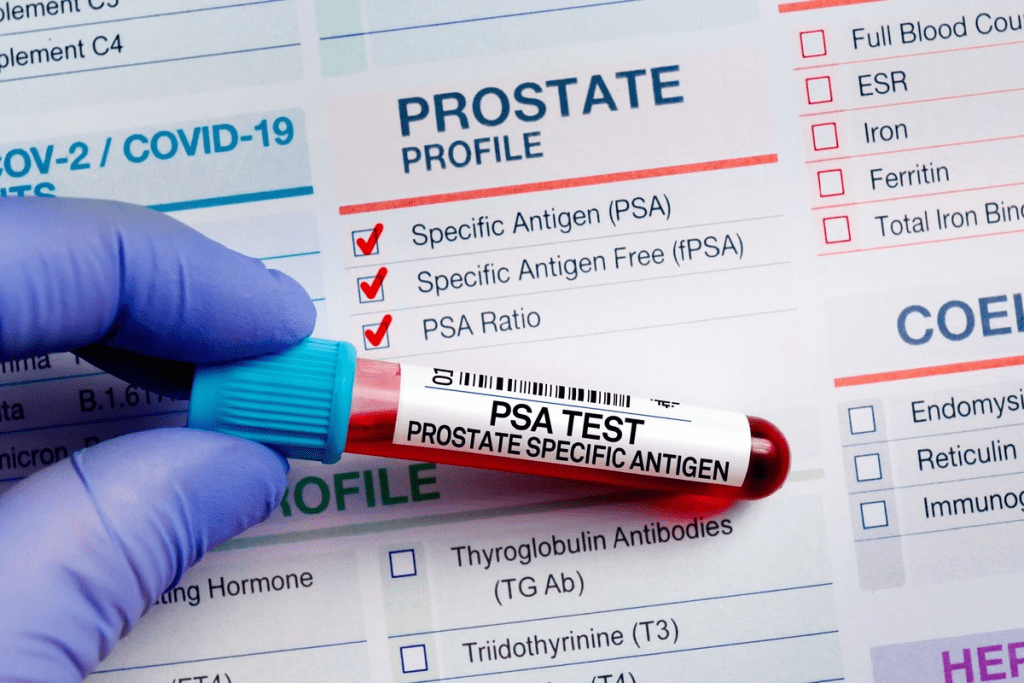Last Updated on October 31, 2025 by

Prostate cancer screening is key for men’s health as they age. The prostate-specific antigen (PSA) test is a blood test used to find prostate cancer early. Understanding PSA levels by age helps doctors decide when screening is most useful and when it may no longer be necessary.
Recent studies show that routine PSA screening is not needed for men 70 and older. Men between 55“69 should talk to their doctor about screening. This decision should be made after weighing the benefits and risks based on PSA levels by age and individual health factors.
The Prostate-Specific Antigen (PSA) test is key for checking prostate health. But many don’t fully understand it. We’ll look into what PSA testing is, how it works, and how screening advice has changed over time.
PSA is a protein made by the prostate gland. High PSA levels in the blood might mean prostate cancer. But they can also show non-cancer issues like prostatitis or BPH. Knowing what PSA is and what it means is key to understanding test results.

PSA testing is a blood test that checks PSA levels. Results are given in nanograms per milliliter (ng/mL). While no PSA level confirms cancer, high levels mean a higher risk. The test is not a direct diagnosis but points to the need for more checks.
Guidelines for PSA screening have changed a lot over time. Groups like the U.S. Preventive Services Task Force (USPSTF) and the Centers for Disease Control and Prevention (CDC) have updated their advice. For example, the USPSTF and CDC say men aged 55“69 should talk to their doctor about screening.
On the other hand, the Canadian Task Force on Preventive Health Care advises against screening for men over 70. This shows how PSA testing advice varies by age and individual risk.
Understanding PSA levels by age and their impact on prostate health is vital. This knowledge helps men make better health choices with their doctors.
As men get older, their Prostate-Specific Antigen (PSA) levels change. It’s key to know what’s normal for different ages. Understanding how age affects PSA levels helps men make better health choices.

PSA levels are measured in nanograms per milliliter (ng/mL) of blood. A PSA level below 4 ng/mL is usually normal. But, this can change with age.
For men aged 40 to 49, a normal PSA is up to 2.5 ng/mL. Men aged 50 to 59 should see levels up to 3.5 ng/mL. And for those 60 to 69, it’s up to 4.5 ng/mL. Knowing these age-specific PSA ranges helps spot issues early.
An elevated PSA doesn’t always mean cancer. It can also be due to prostatitis or BPH. But, higher levels do raise the risk of prostate cancer. For example, a PSA over 10 ng/mL is a big concern.
Younger men (40-49) should watch for PSA levels above 2.5 ng/mL. For older men (60-69), levels over 4.5 ng/mL are more concerning.
Many things can change PSA levels, not just cancer. These include:
Talking to a healthcare provider about these factors is important. They can help understand what PSA levels mean for your health.
Research shows PSA screening can lead to overdiagnosis. Up to 50% of cancers found by PSA might not be aggressive. This shows why it’s vital to consider age and health when looking at PSA levels.
Knowing when to get a PSA test is key for men of all ages. It helps catch prostate problems early. The American Urological Association says it’s best to talk about PSA tests with your doctor. This is because everyone’s health is different.
Men under 55 usually don’t need routine PSA tests unless they have a family history of prostate cancer. This is because prostate cancer is rare in this age group. It helps avoid too many tests and treatments.
Shared decision-making is very important here. It lets men and doctors decide together. They consider each person’s unique situation.
Men between 55 and 69 are in a key age for PSA tests. They should talk to their doctors about getting tested. This helps decide if and how often to get a PSA test.
The USPSTF says men in this age group should talk about their health. They should discuss their risk factors and decide on PSA tests.
How often to get a prostate check depends on several things. It includes the PSA level and other health factors. Men with a low PSA might get tested every 2-4 years. Those with a higher PSA might need tests every 1-2 years.
Men over 75 often have more serious prostate cancer. This shows why older men might not need PSA tests as often. It’s about looking at each person’s life expectancy.
So, how often to get a prostate check is a personal choice. It should be based on your health, what you prefer, and talking it over with your doctor.
For men aged 70 and above, the benefits of PSA testing are being reevaluated. As we age, the risks of PSA testing, like overdiagnosis and unnecessary treatments, grow. Health organizations have updated their guidelines to reflect this change.
The United States Preventive Services Task Force (USPSTF) and the Centers for Disease Control and Prevention (CDC) have new guidelines. They suggest a more careful approach to PSA testing for older men. Routine PSA screening is not recommended for men aged 70 and older, according to these guidelines.
“The USPSTF recommends that men aged 70 and older should not be screened for prostate cancer with the PSA test.”
USPSTF Guidelines
PSA testing is no longer recommended after age 70 due to limited survival benefits. Studies show that PSA screening’s benefits in reducing prostate cancer mortality are less clear in older men. This is because older men often die from other causes before prostate cancer becomes dangerous.
Overdiagnosis is a big issue with PSA testing in older men. It means finding cancers that wouldn’t have caused symptoms or death. This can lead to unnecessary treatments, which can harm a man’s quality of life. It’s important to weigh the benefits and risks of PSA testing, as Liv Hospital emphasizes.
With over 1 million US men getting PSA tests every year, knowing the age-specific guidelines is key. For men over 70, the focus moves from routine screening to a more tailored approach. This considers a man’s health, life expectancy, and personal values.
As men get older, deciding on Prostate-Specific Antigen (PSA) screening gets harder. The benefits of catching cancer early must weigh against the risks of too many tests.
Healthy older men might see benefits from PSA tests. Finding cancer early can save lives by treating it when it’s easier. Guidelines say men with more than 10 years to live might keep screening.
Some key benefits include:
But, PSA tests have risks too. False positives can cause worry, biopsies, and treatments with side effects. This is a big worry for older men, where slow-growing tumors might not shorten life.
The risks associated with PSA screening include:
Knowing what’s normal for older men’s PSA levels is key. For men 75 or older, a PSA under 4.0 ng/mL is often okay. But health and prostate size can change this.
How high a PSA level is a concern depends on many things. Like how fast it’s rising and how high it is compared to normal. A quick rise or a very high level means you should see a doctor.
Men and doctors need to talk about PSA levels and health. Making a decision together is important for whether to keep or stop screening.
Deciding when to stop PSA testing is a big deal. It involves looking at health and personal factors. Men and their doctors work together to make these decisions.
Good decisions start with talks between patients and doctors. They talk about the good and bad sides of PSA tests. For men 55-69, the American Urological Association says it’s up to each person.
Key discussion points include what PSA test results mean, the chance of finding cancer that won’t be a problem, and false positives. These talks help men make choices that fit their health and values.
A man’s health and how long he might live are key. Older men or those with serious health issues might not get much benefit from more tests. The risks of finding cancer that’s not a problem might be too high.
Men who are expected to live longer might get more benefit from tests. But those with shorter life expectancies might not. This helps doctors make decisions based on each person’s health.
What a man values and prefers is very important. Some might worry about the risks of treatment. Others might want the peace of mind that comes with regular tests.
Patient preferences should be listened to. This way, the decision to keep or stop PSA tests matches what the man wants.
Family history and personal risk factors matter too. Men with a family history of prostate cancer or other risks might need different testing plans.
Doctors can give personalized recommendations based on these factors. This helps men make better choices about PSA tests.
Managing prostate health is a delicate balance. Knowing PSA levels by age helps make smart choices. Research shows early detection is key, but so is avoiding treatments that harm quality of life.
Men should talk to their doctors about their health risks. This way, they can find the best care for their prostate. Liv Hospital focuses on personalized healthcare, showing how important it is for each person’s needs.
It’s all about finding the right time to check for prostate issues. Knowing how often a man should have his prostate checked and PSA by age helps him stay proactive. This ensures he gets the care he needs without unnecessary harm.
Normal PSA levels change with age. For men under 55, a normal PSA is below 2.5 ng/mL. Men between 55-69 should aim for below 3.5 ng/mL. And for those over 70, it’s often below 4.0 ng/mL, sometimes a bit higher.
How often to check the prostate varies. It depends on age, risk factors, and past test results. Men under 55 with low risk might not need regular tests. Those 55-69 should talk to their doctor about how often to get tested, maybe every 2-4 years.
What’s considered a high PSA level changes with age. For example, a PSA over 4.0 ng/mL is usually high. But for younger men, a PSA over 2.5 ng/mL might be seen as high.
Testing after 70 is not usually needed. The benefits of screening lessen with age. The risks of finding and treating non-serious conditions increase, which is not good for men with short life expectancies.
Normal PSA levels vary by age. For men under 55, it’s below 2.5 ng/mL. For those 55-69, it’s below 3.5 ng/mL. For men over 70, it might be slightly higher, depending on health and guidelines.
Very high PSA levels are linked to advanced prostate cancer. There’s no direct link to death from PSA levels. But, very high levels (over 100 ng/mL) often mean aggressive or spread-out cancer.
For a 75-year-old, a normal PSA is slightly higher. It’s often up to 6.5 ng/mL or a bit more. This depends on health and any prostate issues.
Many things can change PSA levels. This includes prostatitis, BPH, urinary infections, recent ejaculation, and some medical procedures.
After 70, routine PSA tests are not usually needed. They are only recommended for men in good health with a life expectancy of 10-15 years or more. The decision should be based on individual health and preferences.
Shared decision-making is key in PSA testing. It helps men make informed choices about screening. This is based on their risk, health, and values, with their doctor’s advice.
David, M. K. (2024). Prostate-Specific Antigen – StatPearls. In StatPearls. https://www.ncbi.nlm.nih.gov/books/NBK557495/
Subscribe to our e-newsletter to stay informed about the latest innovations in the world of health and exclusive offers!